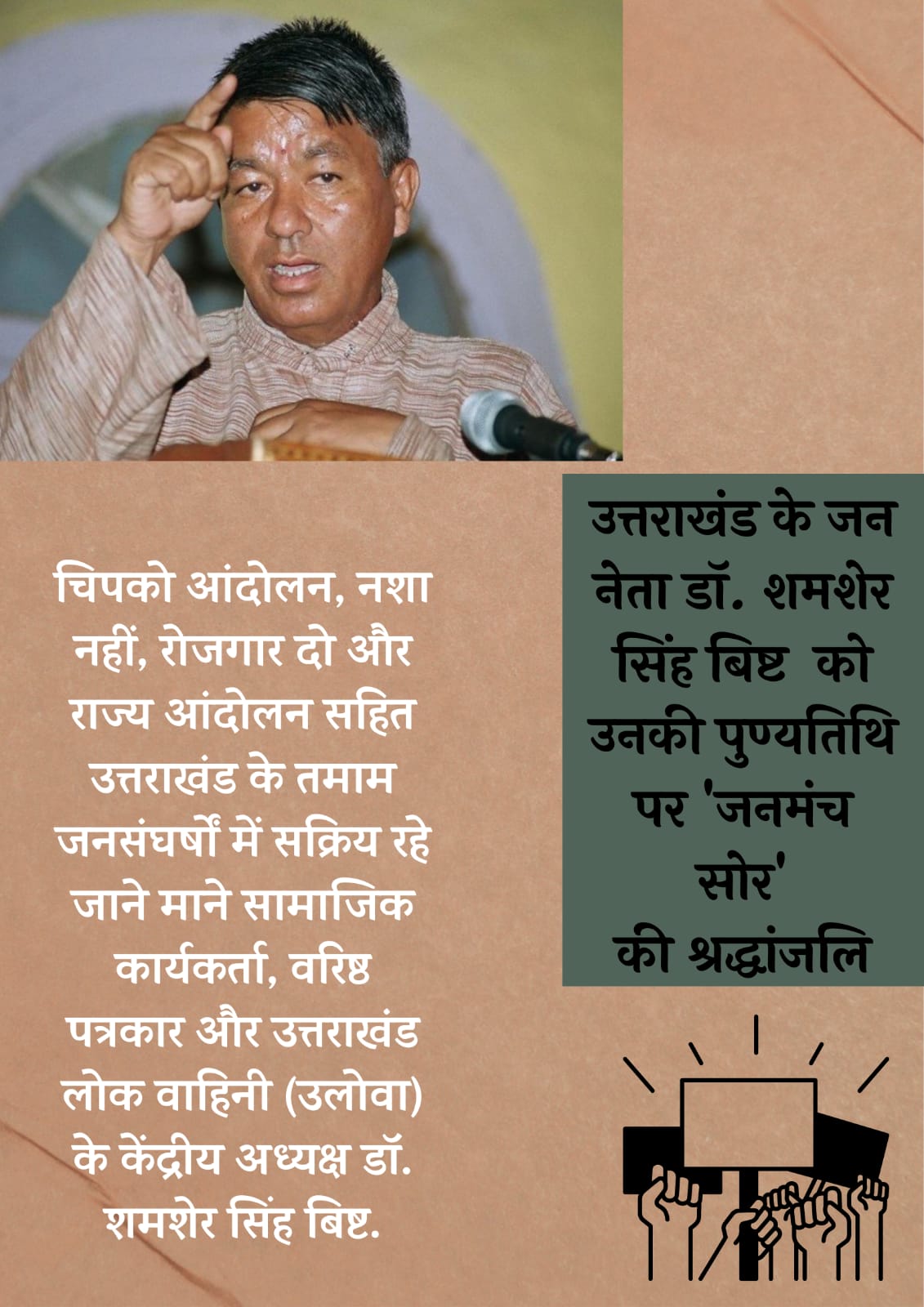A legend of Uttarakhand Dr. Shamsher Singh Bisht is no more
 A legend of Uttarakhand Dr. Shamsher Singh Bisht is no more. https://www.newsviewsnetwork.com/a-legend-of-uttarakhand-dr-shamsher-singh-bisht-is-no-more-dies-at-73/ INDIAA legend of Uttarakhand Dr. Shamsher Singh Bisht is no more.
A legend of Uttarakhand Dr. Shamsher Singh Bisht is no more. https://www.newsviewsnetwork.com/a-legend-of-uttarakhand-dr-shamsher-singh-bisht-is-no-more-dies-at-73/ INDIAA legend of Uttarakhand Dr. Shamsher Singh Bisht is no more.
The land of abode of Gods Uttarakhand has today lost a relentless fighter, journalist, author, an ideologue, a social reformer, a committed activist, prominent Uttrakhand separate state activist n leader and the former student and youth leader with progressive ideals and principles.
He was an active participant and a youth pioneer in various movements such as Chipko, Nasha Nahi Rojgaar Do, movements for environmental protection and for the conservation of forests, water and land in Uttarakhand. Dr. Shamsher Singh Bisht regularly wrote on the soci economic, cultural, environmental and societal issues of Uttarakhand in the leading state dailies n other vernacular periodicals like Jan Satta, Amar Ujala, Dainik Jagran, Nav Bharat Times, etc.
शमशेर सिंह बिष्ट https://www.nainitalsamachar.org/shamsher-singh-bisht/
शमशेर सिंह बिष्ट के जन्मदिन पर विशेष : सुनो उस राजा की कहानी | पास ना जिसके घोड़ा पालकी ना थी राजधानी
Corporatising Agriculture - Not just Adani, Global Capital
Corporatising Agriculture and Foreign Investors -Farmer-owned Sahyadri Farms has raised Rs 310 crore from a group of European investors By Jayashree Bhosale Sep 14, 2022, https://economictimes.indiatimes.com/news/company/corporate-trends/farmer-owned-sahyadri-farms-has-raised-rs-310-crore-from-a-group-of-european-investors/articleshow/94202814.cms Foreign investment story of Sahyadri FPO is now become the discussion points amongst all of us mainly in the development and FPO sector.
South-Up. The South as New Political Imaginary
Bharat Jodo Yatra has opened room for new imagination of India — ‘South-up’ Yogendra Yadav 14 September, 2022 https://theprint.in/opinion/bharat-jodo-yatra-has-opened-room-for-new-imagination-of-india-south-up/1127886/ If we have to resist majoritarianism, we must turn to the three ideological pillars of Dravidian politics: Regionalism, rationalism, and social justice in new ways.
Professor G. N. Devy has a name for this imagination: Dakshinayan. It is the name of the movement he started with many other writers in 2016. We were lucky that he had also come for the inauguration of the yatra and was there with us at the breakfast table that morning. Over idli sambhar and a good cup of my favourite South Indian filter coffee, he explained to us the concept and the story of Dakshinayan. You must hear from him the story of how his wife Surekha and he shifted their home from Vadodara in Gujarat to Dharwad in Karnataka to be with the wife of Professor M. M. Kalburgi after he was assassinated by Right-wing forces. Professor Devy was attracted to the dual significance of Dakshinayan: Its southern orientation as opposed to the north orientation of ‘uttarayan’, and also as a political metaphor for the times when days are short and nights long. ( see also Ganesh Devy Dakshinayan Samas 2018 Sevagram https://www.youtube.com/watch?v=B68TesJA7dM
Extract from Corrine Kumar: The south as the new political imaginery
To all those who listen to the Song of the Wind:
In a different place, in a different time, Black Elk heard the Song of the Wind
I saw myself on the central mountain of the world, the highest place, and I had a vision because I was seeing in the sacred manner of the world, she said
Remember she said, she was seeing in the sacred manner of the world
And the sacred, central mountain was a mountain in her part of the world
“But,” Black Elk continued to say: “the central mountain is everywhere”
From my central mountain, the point where stillness and movement are together, I invite you to listen to the wind;
more specially to the wind from the South: the South as third world, as the civilizations of Asia, the Pacific, the Arab world, Africa, Latin America; the South as the voices and movements of peoples, wherever these movements exist; the South as the visions and wisdoms of women: the South as the discovering of new paradigms, which challenge the existing theoretical concepts and categories breaking the mind constructs, seeking a new language to describe what it perceives, refusing the one, objective, rational, scientific world view as the only world view: the South as the discovery of other cosmologies, as the discovery of other knowledges that have been hidden, submerged, silenced. The South as an “insurrection of these subjugated knowledges”
The South as history; the South as mystery
The South as the finding of new political paradigms, inventing new political patterns, creating alternative political imaginations: the South as the revelation of each civilization in its own idiom: the South as conversations between civilizations:
The South then as new universalisms
And in our searching for new understandings of the South, it promises to bring to the world new meanings, new moorings.
It invites us to create a new imaginary to birth a new cosmology;
The South then as new political imaginary
Yogendra Yadav
Page 25 of 51
